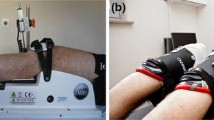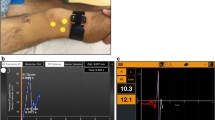Abstract
Purpose
Despite the overall success of the surgical anterior cruciate ligament (ACL) reconstruction, some patients still present with instability symptoms even after the surgery, mainly due to the presence of associated lesions. At present, the pivot shift test has been reported to be the benchmark to assess rotatory knee laxity. The purpose of this study was to quantitatively evaluate rotatory knee laxity at time-zero in order to determine whether detected post-reconstruction laxity was predictable by its value measured before the reconstruction, which was hypothized to be influenced by the presence of associated lesions.
Methods
Rotatory knee laxity was retrospectively analysed in 42 patients, including two different ACL reconstructions. The maximal anterior displacement and the absolute value of the posterior acceleration reached during the reduction of the tibial lateral compartment were intra-operatively acquired by using a navigation system and identified as discriminating parameters. For each parameter, statistical linear regression analysis (line slope and intercept) was performed between pre- and post-reconstruction values.
Results
No statistically significant influence of the initial posterior acceleration on the post-reconstruction outcome was found (line slope, p > 0.05), although a statistically significant line intercept was indeed identified (p < 0.001). A statistically significant influence on the surgery outcome was instead found for the initial value of the anterior tibial displacement (line slope = 0.39, p = 0.004), meaning that, on average, about 40 % of the post-reconstruction lateral compartment displacement could be explained by the corresponding pre-reconstruction value. Both of these findings highlighted the importance of intra-operative quantification of rotatory knee laxity to identify correct indications for the surgery.
Conclusions
This study provided important implications for the future possibility of defining a quantifying tool able to assess rotatory knee laxity during ACL reconstruction. This could allow detection of additional injuries to secondary restraints by easily performing rotatory knee laxity tests, which in turn could reduce post-surgical recurrence of knee instability.

Similar content being viewed by others
References
Freedman KB, D’Amato MJ, Nedeff DD et al (2003) Arthroscopic anterior cruciate ligament reconstruction: a metaanalysis comparing patellar tendon and hamstring tendon autografts. Am J Sports Med 31:2–11
Kocher MS, Steadman JR, Briggs KK et al (2004) Relationships between objective assessment of ligament stability and subjective assessment of symptoms and function after anterior cruciate ligament reconstruction. Am J Sports Med 32:629–634
Markolf KL, Jackson SR, McAllister DR (2010) Relationship between the pivot shift and Lachman tests: a cadaver study. J Bone Joint Surg Am 92:2067–2075
Streich NA, Reichenbacher S, Barié A et al (2013) Long-term outcome of anterior cruciate ligament reconstruction with an autologous four-strand semitendinosus tendon autograft. Int Orthop 37:279–284
Leiter JRS, Gourlay R, McRae S et al (2013) Long-term follow-up of ACL reconstruction with hamstring autograft. Knee Surg Sports Traumatol Arthrosc. doi:10.1007/s00167-013-2466-3
Sena M, Chen J, Dellamaggioria R et al (2013) Dynamic evaluation of pivot-shift kinematics in physeal-sparing pediatric anterior cruciate ligament reconstruction techniques. Am J Sports Med 41:826–834
Duncan JB, Hunter R, Purnell M, Freeman J (1995) Meniscal injuries associated with acute anterior cruciate ligament tears in alpine skiers. Am J Sports Med 23:170–172
Signorelli C, Bonanzinga T, Lopomo N et al (2013) Do pre-operative knee laxity values influence post-operative ones after anterior cruciate ligament reconstruction? Scand J Med Sci Sports 23:e219–e224
Johnson DL, Coen MJ (1995) Revision ACL surgery. Etiology, indications, techniques, and results. Am J Knee Surg 8:155–167
Ahldén M, Samuelsson K, Fu FH et al (2013) Rotatory knee laxity. Clin Sports Med 32:37–46
Noyes FR, Mooar PA, Matthews DS, Butler DL (1983) The symptomatic anterior cruciate-deficient knee. Part I: the long-term functional disability in athletically active individuals. J Bone Joint Surg Am 65:154–162
Lane CG, Warren R, Pearle AD (2008) The pivot shift. J Am Acad Orthop Surg 16:679–688
Losee RE (1983) Concepts of the pivot shift. Clin Orthop Relat Res 172:45–51
Musahl V, Hoshino Y, Becker R, Karlsson J (2012) Rotatory knee laxity and the pivot shift. Knee Surg Sports Traumatol Arthrosc 20:601–602
Musahl V, Seil R, Zaffagnini S et al (2012) The role of static and dynamic rotatory laxity testing in evaluating ACL injury. Knee Surg Sports Traumatol Arthrosc 20:603–612
Galway HR, MacIntosh DL (1980) The lateral pivot shift: a symptom and sign of anterior cruciate ligament insufficiency. Clin Orthop Relat Res 147:45–50
Hoshino Y, Kuroda R, Nagamune K et al (2012) Optimal measurement of clinical rotational test for evaluating anterior cruciate ligament insufficiency. Knee Surg Sports Traumatol Arthrosc 20(7):1323–1330
Lopomo N, Zaffagnini S, Amis AA (2013) Quantifying the pivot shift test: a systematic review. Knee Surg Sports Traumatol Arthrosc 21:767–783
Lopomo N, Zaffagnini S, Bignozzi S et al (2010) Pivot-shift test: analysis and quantification of knee laxity parameters using a navigation system. J Orthop Res 28:164–169
Kuroda R, Hoshino Y, Nagamune K et al (2008) Intraoperative measurement of pivot shift by electromagnetic sensors. Oper Tech Orthop 18:190–195
Benjaminse A, Gokeler A, van der Schans CP (2006) Clinical diagnosis of an anterior cruciate ligament rupture: a meta-analysis. J Orthop Sports Phys Ther 36:267–288
Kaplan N, Wickiewicz TL, Warren RF (1990) Primary surgical treatment of anterior cruciate ligament ruptures. A long-term follow-up study. Am J Sports Med 18:354–358
Andriacchi TP, Mündermann A, Smith RL et al (2004) A framework for the in vivo pathomechanics of osteoarthritis at the knee. Ann Biomed Eng 32:447–457
Karlson JA, Steiner ME, Brown CH, Johnston J (1994) Anterior cruciate ligament reconstruction using gracilis and semitendinosus tendons. Comparison of through-the-condyle and over-the-top graft placements. Am J Sports Med 22:659–666
Marcacci M, Zaffagnini S, Iacono F et al (1998) Arthroscopic intra- and extra-articular anterior cruciate ligament reconstruction with gracilis and semitendinosus tendons. Knee Surg Sports Traumatol Arthrosc 6:68–75
Martelli S, Zaffagnini S, Bignozzi S et al (2007) Description and validation of a navigation system for intra-operative evaluation of knee laxity. Comput Aided Surg 12:181–188
Hoshino Y, Araujo P, Ahlden M et al (2012) Standardized pivot shift test improves measurement accuracy. Knee Surg Sports Traumatol Arthrosc 20(4):732–736
Zaffagnini S, Marcheggiani Muccioli GM, Lopomo N et al (2012) Can the pivot-shift be eliminated by anatomic double-bundle anterior cruciate ligament reconstruction? Knee Surg Sports Traumatol Arthrosc 20:743–751
Grood ES, Suntay WJ (1983) A joint coordinate system for the clinical description of three-dimensional motions: application to the knee. J Biomech Eng 105:136–144
Musahl V, Kopf S, Rabuck S et al (2011) Rotatory knee laxity tests and the pivot shift as tools for ACL treatment algorithm. Knee Surg Sports Traumatol Arthrosc 20:793–800
Lopomo N, Zaffagnini S, Signorelli C et al (2011) An original clinical methodology for non-invasive assessment of pivot-shift test. Comput Methods Biomech Biomed Engin 15(12):1323–1328
Yamamoto Y, Ishibashi Y, Tsuda E et al (2010) Comparison between clinical grading and navigation data of knee laxity in ACL-deficient knees. Sports Med Arthrosc Rehabil Ther Technol 2:27
Lane CG, Warren RF, Stanford FC et al (2008) In vivo analysis of the pivot shift phenomenon during computer navigated ACL reconstruction. Knee Surg Sports Traumatol Arthrosc 16:487–492
Jonsson H, Riklund-Ahlström K, Lind J (2004) Positive pivot shift after ACL reconstruction predicts later osteoarthrosis: 63 patients followed 5–9 years after surgery. Acta Orthop Scand 75:594–599
Ahldén M, Hoshino Y, Samuelsson K et al (2012) Dynamic knee laxity measurement devices. Knee Surg Sports Traumatol Arthrosc 20(4):621–632
Struewer J, Ziring E, Frangen TM et al (2013) Clinical outcome and prevalence of osteoarthritis after isolated anterior cruciate ligament reconstruction using hamstring graft: follow-up after two and ten years. Int Orthop 37:271–277
Acknowledgments
We would like to acknowledge all the staff of II Clinica Ortopedica e Traumatologica at Istituto Ortopedico Rizzoli for their assistance during the study. AV would like to particularly thank Emil Ferretti for his great contribution in the management of technological aspects of the lab. No funding was directly received by any of the authors for the proposed study.
Author information
Authors and Affiliations
Corresponding author
Rights and permissions
About this article
Cite this article
Lopomo, N., Signorelli, C., Bonanzinga, T. et al. Can rotatory knee laxity be predicted in isolated anterior cruciate ligament surgery?. International Orthopaedics (SICOT) 38, 1167–1172 (2014). https://doi.org/10.1007/s00264-014-2287-0
Received:
Accepted:
Published:
Issue Date:
DOI: https://doi.org/10.1007/s00264-014-2287-0




